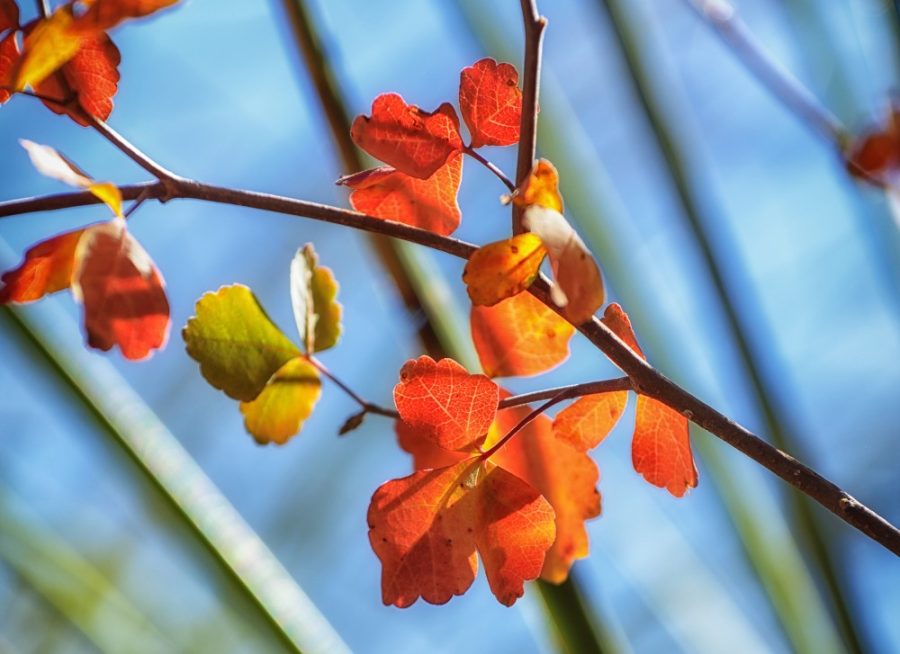While fall may seem almost mythical in the desert, to those with a trained eye, the months of September, October and November bring about a big change in the Tucson valley.
“Fall in the desert is barely detectable to newcomers, but the longer you stay, the more clearly you recognize the signs,” said Tanya Quist, University of Arizona associate professor of practice in the School of Plant Sciences.
Why? Just as we begin to better recognize the changes with time, so have the plants that have lived here far longer than any human Tucsonan, Quist said.
The biggest changes for anyone, or anything, living here are the length of the days and the fluctuations in temperature, according to Charles Weidman, UA professor of hydrology and atmospheric sciences.
“The hottest time of the year occurs in late June, probably just before the arrival of moisture and the start of the summer thunderstorm season,” Weidman said. “High temperatures drop slowly from then until late September, when they start to fall off more quickly.”
Quist said temperature changes affect plant development as well.
“Deciduous plants like the Arizona Ash show changing leaf color until they defoliate for the winter, and native desert plants like desertbroom flower produce copious amounts of pollen,” Quist said.
RELATED: Cannabis and cancer: another connection
People and plants are so interdependent, Quist said, that people go through changes along with the plants when temperatures drop, and that’s not always the most pleasant thing.
“To allergy sufferers, fall may mean bad news, as native plants that bloom in fall take advantage of the fall breezes that kick up to disperse their pollen,” Quist said.
While allergies may be unpleasant for people, Quist said that fall-blooming plants like Desertbroom come with amazing benefits to the ecosystem.
“It is an important shrub that colonizes and stabilizes disturbed areas, and it supports hundreds of native butterflies, bees, wasps and beetles,” Quist said.
 These are not the only plants to show signs of the season, according to Quist.
These are not the only plants to show signs of the season, according to Quist.
“Fall, for many other desert plants, means generous fruit production, including barrel cacti, soapberry trees, desert hackberries and wolfberries ,” Quist said. “[It’s] produce necessary for local fauna and enjoyed by savvy urbanites alike.”
While many of the desert fruits are plenty tasty, Quist said simply their aesthetic beauty is enough to put a smile on your face.
“Certainly with greater attention to observing the plants changing around us, we can begin to see them as sentinels of fall — a fall complete with all the splendor, harvest and abundance associated with the season in other parts of the country,” Quist said.
RELATED: Tracking the bites: Students map mosquito-borne diseases
The first official day of fall was Friday, Sept. 22. The autumnal equinox marks the day when the northern and southern hemispheres are equidistant from the sun. Wiedman said this has a very interesting effect on our street systems.
“I like checking out the sunrise and sunset on the fall equinox,” Wiedman said. “And seeing the sun right at the end of east–west oriented streets.”
While this phenomenon can be seen to a lesser degree in the days prior to and following an equinox, the sun will only line up perfectly on Sept. 22 and March 20.
The equinox and general temperature trends are the same each year, but specific weather patterns vary, according to Weidman.
“It looks like the next three months are likely to be warmer than normal,” Weidman said.
The National Weather Service predicts an over 50 percent chance that southern Arizona will experience warmer-than-average temperatures this fall.
Historically, the beginning of fall in late September averages between the high 60s and mid 90s, according to Accuweather, while the average day in November ranges from 40 to 80 degrees.
Whether you’re new to the area or a long-time Tucsonan, fall in the Sonoran Desert is a pleasant season, and it’s important to take time to recognize and appreciate the sometimes subtle joys that this time of the year brings.
Follow Chandler Donald on Twitter















